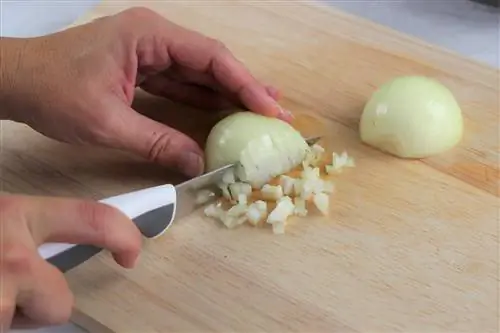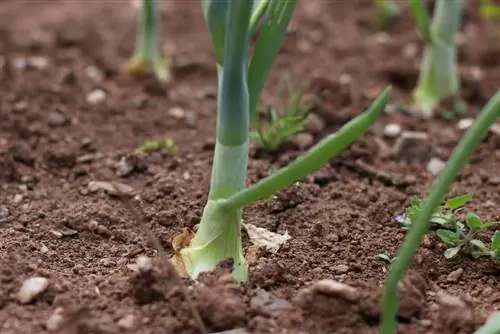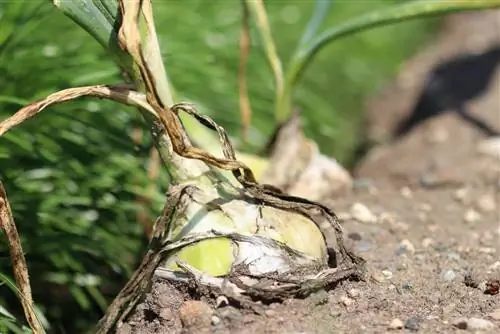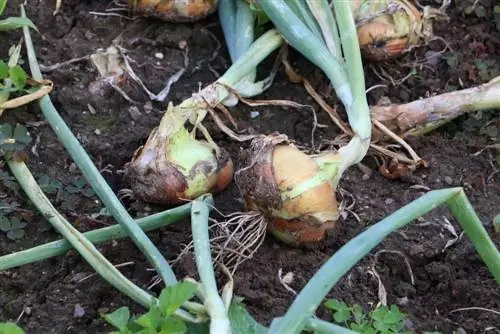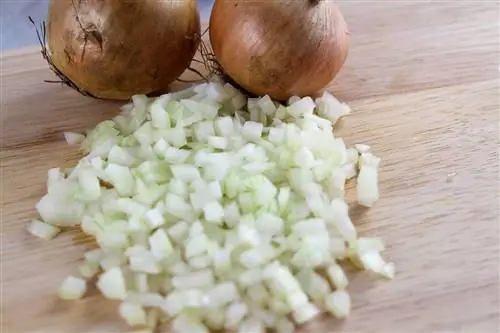- Author admin [email protected].
- Public 2023-12-17 03:39.
- Last modified 2025-01-24 12:45.
At the latest when it comes to preparing goulash for several people, protective measures must be taken against the pungent onion fumes. After all, it's about cutting pounds of onions and preferably without tears. There are many tricks and tricks to cut onions without tears. What's amazing is that most of them make sense. All that remains is to find the most practical solution for yourself. After all, standing at the cutting board with diving goggles or your tongue hanging out is not for everyone.
Cause, effect
If you know what causes the burning in your eyes, you will be able to quickly identify which techniques make sense and which ones make less sense. As soon as an onion is cut it starts. A gas forms that immediately rises into the nose and eyes. Every onion cell contains iso-alliin, a sulfur-containing amino acid, in the outer cell layer. An enzyme called alliinase lurks inside the cell. With a cut through the onion, both compounds come into contact with each other. The enzyme breaks down the amino acid and produces propene sulfenic acid. This acid forms further compounds, oxygen from the air is added and the irritating exhaust gas propanethial-S-oxide is created. If this gas hits the eyes and respiratory tract, defensive measures are immediately taken to expel the irritants. You cry, as the saying goes, snot and water. A little consolation in advance. Even if this is more than unpleasant, it is definitely not harmful to your he alth.
The onion uses this compound as protection against predators. This could be a bite from a vole or a cut with a knife. Different types of onions also produce gases of different strengths. Even the cultivation, origin and harvest time of the same onion varieties can produce different levels of irritant gases. On the other hand, we humans also react differently to it. While some people burst into tears just by chopping parsley and radishes, others need the strong stimulus of a fresh, common household onion. The brown onion is one of the hottest onion varieties. It is particularly rich in iso-alliin. This defensive substance can also benefit us humans. The therapeutic effect of the onion is described in medicine as, among other things, antibacterial, anti-inflammatory and germicidal.
Tool
Selecting the right cutting tool can mitigate the gas escape. A smooth cut through the cell walls with a very sharp knife prevents the two trigger substances from coming together so quickly. However, if the cells are squeezed at the same time during cutting by a blunt tool, the juices spray out and can react with each other immediately. So the first step: use a sharp knife! With just one onion, that can be enough to keep you from bursting into tears. In addition, at least one sharp all-purpose kitchen knife should be part of the basic equipment in every kitchen.
Simple measures
Even small, simple measures can greatly reduce irritation to the eyes and respiratory tract:
- Instead of standing, cut the onions while sitting. The eyes and nose are automatically no longer directly above the cutting board, but are moved slightly back.
- Open a window when cutting onions or make sure there is a draft. Anyone who can work near an open window will probably be able to chop one or two onions without shedding tears.
- Most contact lens owners probably already know this. If you wear the lenses instead of glasses, you won't cry so easily while cutting onions.
Tip:
Another effective measure is to delegate kitchen tasks straight away. So this unpleasant work can be done either by less sensitive people or by an electric chipper.
The nose
If you can only breathe through your mouth while cutting onions, you are almost on the safe side. The gas that is inhaled through the nose along with the air passes through the olfactory nerves. These are close to the tear glands, which are also stimulated. So no air through the nose means no tears. You can quickly see the effect for yourself with a quick self-experiment. When cutting onions, open your mouth and close your nose:
- If you can, breathe disciplined through your mouth or use a nose clip.
- Whistle a song and only take a breath through your mouth. The air flow from the mouth also removes the rising gases from the face.
- Swimming goggles also belong to the topic of noses. If it is just a pair of glasses that only seals the eyes airtight so that the gases can get into the nose unhindered, tears will still occur. A combination with the nose clip would be useful here.
- Not everyone may want to work in the kitchen with their tongue hanging out while breathing through their mouth. But that would also be a possibility.
More complex measures
The following methods require some preparation or the use of certain tools:
- Sounds a bit strange, but it's supposed to be effective. Light a candle to the right and left of the cutting board. The rising gas is attracted to the flames of the candles.
- Cut the onions very close to running, hot water
- or near a pot of boiling water from which clouds of steam are happily rising. The haze in the kitchen may not be for everyone. Just like wasting hot drinking water from the tap.
- Make sure you have the right amount of air or create it yourself with a fan. The air flow should of course direct the rising gases away from the face on the side of the cutting board.
- Another airy option is to place the cutting board on the stove. Then the extractor hood is switched on, to full power.
- Chemical control methods are also possible. However, you can influence the taste of the onion. Solutions containing acid and s alt denature the enzyme allinase from inside the cell. To achieve this effect, you can either add some vinegar to the cutting board or soak the onion in s alt water for some time.
- The irritant gases can also be reduced by cooling the onions beforehand. When a cold onion is cut, fewer enzymes are released into the air. To do this, place the onions in the freezer for about five minutes. They would need to cool in a normal refrigerator for up to 20 minutes.
Dubious measures
There are also tricks that you read about again and again, but which are either difficult to implement or simply don't help:
- Cut onions in water. Keyword, yes, where are the onion cubes floating? Valuable ingredients are also simply washed away.
- The same problems are likely to arise when cutting onions under running water.
- Soaking in water for a long time is also not advisable. The onion is not only slippery and therefore difficult to hold, but valuable ingredients are also washed out and the onion loses its spiciness.
- You can often also find tips to chew bread or chewing gum. Maybe this is indeed a bit distracting, but it can't stop the gases from entering your eyes and nose.
Tip:
There is another, more passive method to completely avoid the irritation caused by onion fumes. For example, by using particularly mild onion varieties, such as shallots, white or red onions. However, this could lead to a significant loss of taste, at least in the case of the goulash pot mentioned at the beginning.
Conclusion
With this we alth of measures, everyone is sure to find the best technique for cutting onions. There will hardly be any reason to avoid this he althy and tasty vegetable because of the gases that irritate the mucous membranes. Perhaps the easiest and most useful tip is definitely to use a sharp knife. This not only makes all the chopping and chopping work in the kitchen easier and faster, it also makes working with it more fun.

